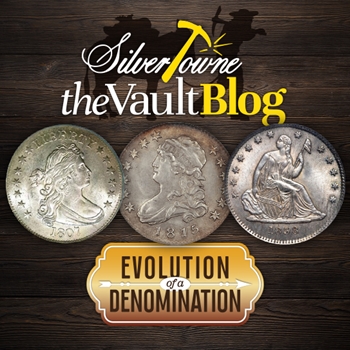
Mentioned a number of times throughout this series, the Coinage Act of April 2, 1792, established a mint and the regulation of coins of the United States. This not only established what is now known as the United States Mint, but the production of coins in silver, gold, and copper with denominations from half cents all the way to ten dollar gold eagles. While authorized in 1792, the quarter dollar denomination did not actually start getting issued until 1796
Draped Bust (1796-1807)
Designing the 1796 quarter dollar was of utmost importance to the Mint as previous coinage such as the Chain cent and Wreath cent in addition to the Flowing Hair design were met with public dismay. Mint Director Henry DeSaussure commissioned designer and portraitist Gilbert Stuart for the obverse of the Draped bust quarter as he previously used Mrs. William Bingham (Ann Willing) as the likeness of the portrait that appeared on the Draped Bust dollar that was issued in 1795. However her likeness brought difficulties upon transferring the sketch to the coin and the portrait that ended up on the 1796 quarter dollars were considered “bland.” The design failure would also be later pointed at Robert Scot. While hired as an engraver at the Mint, it was later found that he could not sink a die or make a device punch deeming him incompetent for the job at hand.
Only 6,146 Draped Bust quarter dollars (Small Eagle Reverse) were struck in 1796. They were not struck again until 1804 when the Heraldic Eagle Reverse would take over after nearly a decade. With just 6,738 quarter dollars being struck with the new changes in the first year, a total of 554,899 were struck over the four year period until 1807 when the denomination was suspended due to not being used. The public were still using the Spanish and Mexican two-reales coins, causing production to cease until 1815.
Capped Bust (1815-1838)
Little demand for quarters translated into none of them being produced between 1808-1814. Quarters that were minted in 1815 were done so because the bank ordered them to be made. This resulted in the Capped Bust design created by German engraver, John Reich. A little over 89,000 were produced all at Philadelphia. However, a fire at the Mint would destroy the machines and the production of quarters once again shut down until 1818. Again, the quarter dollar was in such low demand that no one even noticed the time gap.
The Capped Bust quarter dollar would continue to be produced up until 1838 with gap years and design changes throughout that time. However, William Kneass would come in as the designer of the Variety 2 (1831-1838) that would see a reduction in diameter and the motto removed. The design would end abruptly during mid-1838 when dies were already being prepared for the new Seated Liberty design.
Liberty Seated (1838-1891)
With the addition of Christian Gobrecht to the Mint, his work immediately involved updating and improving current United States coinage. With influence by the seated goddess found on British coinage, Gobrect would bring new life to a dollar coin. When those patterns were released in December of 1836, the Mint was determined to have the same design on all the silver coins being used. This is when Gobrecht started working on the other denominations, including the quarter dollar.
While the Liberty Seated design was used from 1838-1891, there were a number of varieties throughout the series. From 1838 to 1853, Variety 1 was called the No Motto Above Eagle. Nearly one million coins were struck during this time until the Variety 2 With Arrows and Rays was adopted. However, that variety only lasted for a year when the Variety 3 Arrows No Rays took over. More varieties would come throughout the years with slight alterations to the design. The Liberty Seated quarter dollar would eventually cease production in 1892 when it was replaced with Charles Barber’s design.
Source: NGC Coin, The Official Red Book (2022)







